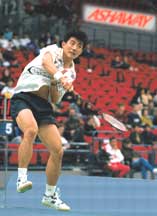|
|

Stringing For Tournament Play
By Steve Crandall
Vice President, Sales & Marketing
Ashaway Racket Strings
 Tournament badminton is more demanding than practice or recreational play. It's also tougher on your equipment. Here's how to ensure that your gear is up to the challenge. Tournament badminton is more demanding than practice or recreational play. It's also tougher on your equipment. Here's how to ensure that your gear is up to the challenge.
Good preparation is essential. Before any tournament, you should have resolved, at least temporarily, any questions about your equipment. Serious competition is no time to experiment with different racquets, string, shoes, or anything else. After the tournament, you will analyze every decision and every move you made, and that might involve reevaluating equipment choices. But going in, you must have confidence in your equipment, so that you can devote full attention to your play.
Supply yourself with numerous racquets, and take the time to become familiar with all of them. When you break a string in the middle of a match, or when the string begins to lose its tension, you want to be able to switch to another racquet and continue playing as if nothing had happened. This is no time to get the feel for a new setup. I'd recommend a minimum of three racquets, although five or six is not unreasonable.
Ideally, the racquets should be identical. In practice, few can afford to replace all their racquets simultaneously, so most players have a collection consisting of their newest, favorite racquet, followed by the second-newest, second-favorite, etc. This makes it essential that you settle on your favorite stringing setup for each racquet before the tournament.
The racquets should be strung to your specifications by your favorite stringer, on his usual machine. For at least four good reasons, you should use the tournament's on-site stringers only when necessary. First, they don't know you or your preferences. Second, even professional stringers use different techniques and may get different results. Third, tournament stringers work under incredible time pressure. And fourth, stringing machines differ in quality, condition, and design, and generate results that can vary by several pounds. (Electronic, constant-pull machines consistently produce tighter string jobs than mechanical, fixed-tension machines at the same tension settings.) You can eliminate these variables by arriving with your racquets pre-strung.
But what if you must restring during a tournament? Again, preparation is key. Pack several sets of your favorite string in your gear bag. Know what tension you prefer in each racquet. Ask your regular stringer about any unusual stringing techniques he uses, and find out if he uses a constant-pull or fixed-tension machine. Explain your preferences to the tournament stringer, and ask him to duplicate your usual setup, using your string.
Tournament matches take longer, on average, than recreational matches, because players and teams tend to be more evenly matched, and because every point is taken seriously. Racquet string therefore takes more of a beating, and may lose tension during a single match. Certainly, string breakage is more common in tournaments. Make sure you're ready for these mishaps by having extra racquets ready, and by being prepared to have your racquets restrung according to your needs and preferences.
As a tournament player, you must cope with much that is unfamiliar. You're often playing unknown opponents in unfamiliar surroundings, sleeping in a strange bed, and maybe even trying to adjust to a different time zone. Do yourself a favor and make sure that your equipment, at least, stays the same.
This article previously appeared in USA Badminton.
|